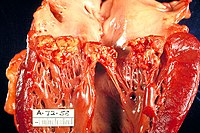
Infective endocarditis after device closure of atrial septal defects: Case report and review of the literature
Sign Up to like & getrecommendations! Published in 2017 at "Catheterization and Cardiovascular Interventions"
DOI: 10.1002/ccd.26784
Abstract: We report a case of late infective endocarditis in an 8‐year‐old boy 3 years after transcatheter closure of an atrial septal defect with the Amplatzer Atrial Septal Occluder Device. Echocardiography showed a very thick pannus… read more here.
Keywords: closure atrial; infective endocarditis; atrial septal; device closure ... See more keywords

Initial clinical experience with the GORE® CARDIOFORM ASD occluder for transcatheter atrial septal defect closure
Sign Up to like & getrecommendations! Published in 2017 at "Catheterization and Cardiovascular Interventions"
DOI: 10.1002/ccd.26907
Abstract: To report the initial clinical experience with a novel atrial septal defect (ASD) closure device, the GORE® CARDIOFORM ASD Occluder (GCO). read more here.
Keywords: cardioform asd; atrial septal; gore cardioform; septal defect ... See more keywords

Pericardial tamponade due to erosion of a Figulla Flex II device after closure of an atrial septal defect
Sign Up to like & getrecommendations! Published in 2019 at "Catheterization and Cardiovascular Interventions"
DOI: 10.1002/ccd.28367
Abstract: We present a case of an 8‐year‐old boy suffering from sudden‐onset severe chest pain and cardiogenic shock due to cardiac tamponade caused by erosion of a Figulla Flex II device. His symptoms developed 4 days… read more here.
Keywords: atrial septal; erosion figulla; septal defect; device ... See more keywords

Transseptal access for left heart structural interventions in the setting of prior atrial septal defect closure
Sign Up to like & getrecommendations! Published in 2019 at "Catheterization and Cardiovascular Interventions"
DOI: 10.1002/ccd.28548
Abstract: A transseptal puncture is critical for “left‐sided” structural heart interventions. Procedures such as transcatheter edge‐to‐edge repair (MitraClip) and left atrial appendage (LAA) closure (Watchman) require precise puncture of the interatrial septum (IAS), and the presence… read more here.
Keywords: heart; closure; left heart; atrial septal ... See more keywords

Unusual interatrial fistula discovered during device closure of an atrial septal defect
Sign Up to like & getrecommendations! Published in 2019 at "Catheterization and Cardiovascular Interventions"
DOI: 10.1002/ccd.28555
Abstract: Atrial septal defect (ASD) closure is a common reason for referral to the cardiac catheterization laboratory. We report a case in which a relatively large Qp:Qs of 1.85:1 was demonstrated in the face of a… read more here.
Keywords: closure; atrial septal; septal defect; fistula ... See more keywords

Morphological assessments of deficient posterior‐inferior rim for transcatheter closure of atrial septal defect
Sign Up to like & getrecommendations! Published in 2020 at "Catheterization and Cardiovascular Interventions"
DOI: 10.1002/ccd.29182
Abstract: This study aimed to determine morphological characteristics of deficient posterior‐inferior rim for transcatheter atrial septal defect (ASD) closure success. read more here.
Keywords: posterior inferior; inferior rim; atrial septal; septal defect ... See more keywords

Transcatheter closure of fenestrated atrial septal aneurysm in children: Feasibility and long‐term results
Sign Up to like & getrecommendations! Published in 2022 at "Catheterization and Cardiovascular Interventions"
DOI: 10.1002/ccd.30191
Abstract: To date, extensive experience in transcatheter closure of fenestrated atrial septal aneurysm (ASA) in the pediatric population is limited. read more here.
Keywords: septal aneurysm; closure fenestrated; transcatheter closure; atrial septal ... See more keywords

Novel technique for transcatheter closure of sinus venosus atrial septal defect: The temporary suture‐holding technique
Sign Up to like & getrecommendations! Published in 2022 at "Catheterization and Cardiovascular Interventions"
DOI: 10.1002/ccd.30415
Abstract: Transcatheter repair of sinus venosus atrial septal defect (SVASD) has become an alternative option to surgical repair. There are potential significant complications related to stent stability in the superior vena cava (SVC) and potential migration… read more here.
Keywords: sinus venosus; atrial septal; venosus atrial; septal defect ... See more keywords

Transcatheter atrial septal defect closure late after completion of biventricular circulation in patients with pulmonary atresia intact ventricular septum or critical pulmonary stenosis
Sign Up to like & getrecommendations! Published in 2023 at "Catheterization and Cardiovascular Interventions"
DOI: 10.1002/ccd.30623
Abstract: This study aimed to explore anatomical and hemodynamic features of atrial septal defect, which was treated by transcatheter device closure late after completion of biventricular circulation in patients with pulmonary atresia and intact ventricular septum… read more here.
Keywords: closure late; completion biventricular; late completion; atrial septal ... See more keywords

Transcatheter versus surgical treatment for isolated superior sinus venosus atrial septal defect
Sign Up to like & getrecommendations! Published in 2023 at "Catheterization and Cardiovascular Interventions"
DOI: 10.1002/ccd.30650
Abstract: The superior sinus venosus atrial septal defect is a congenital communication between the left and right atria. Open surgical approach by patch closure has historically been the only treatment option. Recently, a transcatheter approach has… read more here.
Keywords: sinus venosus; atrial septal; venosus atrial; septal defect ... See more keywords

Paradoxical embolic strokes in a liver transplant recipient with atrial septal defect undergoing therapeutic plasma exchange
Sign Up to like & getrecommendations! Published in 2020 at "Journal of Clinical Apheresis"
DOI: 10.1002/jca.21849
Abstract: Therapeutic plasma exchange (TPE) is a technique used to separate blood components into layers based on their density difference, thus removing plasma and exchanging it with replacement fluids. A variety of adverse reactions has been… read more here.
Keywords: atrial septal; plasma exchange; septal defect; liver transplant ... See more keywords